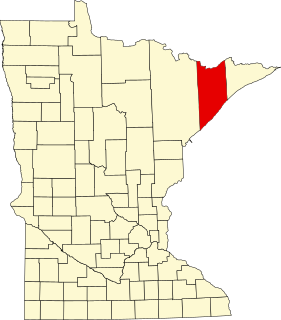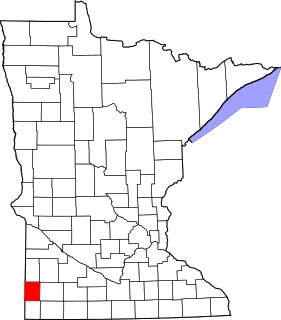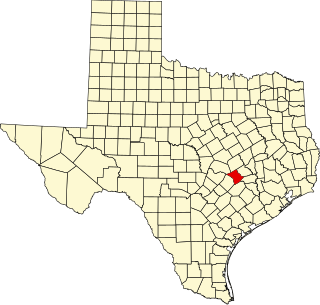
The Appomattox Court House National Historical Park is a preserved 19th-century village in Appomattox County, Virginia. The village is famous for the site of the Battle of Appomattox Court House, and contains the house of Wilmer McLean, where the surrender of the Army of Northern Virginia under Robert E. Lee to Union commander Ulysses S. Grant took place on April 9, 1865, effectively ending the American Civil War. The McLean House was the site of the surrender conference, but the village itself is named for the presence nearby of what is now preserved as the Old Appomattox Court House.

Arlington House, The Robert E. Lee Memorial, formerly named the Custis-Lee Mansion, is a Greek Revival style mansion located in Arlington, Virginia, United States that was once the home of Confederate Army General Robert E. Lee. It overlooks the Potomac River and the National Mall in Washington, D.C. During the American Civil War, the grounds of the mansion were selected as the site of Arlington National Cemetery, in part to ensure that Lee would never again be able to return to his home. The United States has since designated the mansion as a National Memorial. Although the United States Department of the Army controls Arlington National Cemetery, the National Park Service, a component of the United States Department of the Interior, administers Arlington House.

This is a list of the National Register of Historic Places listings in Berkshire County, Massachusetts.

This is a list of properties and historic districts in Missouri on the National Register of Historic Places. There are NRHP listings in all of Missouri's 114 counties and the one independent city of St. Louis.

Leesylvania State Park is located in the southeastern part of Prince William County, Virginia. The land was donated in 1978 by philanthropist Daniel K. Ludwig, and the park was dedicated in 1985 and opened full-time in 1992.
Martin Parks Burks was born in Bedford County, Virginia. His father was Judge Edward C. Burks, who served on the Supreme Court of Appeals from 1876 to 1882. Martin Burks attended Washington and Lee University when he was only fifteen years old. He later entered the University of Virginia and graduated with a Bachelor of Law Degree. In 1872, he was admitted to the bar and began practicing law in Bedford County in partnership with his father. This partnership continued until his father became a member of the Supreme Court of Appeals. The younger Burks remained in practice at Bedford until he returned to Washington and Lee in 1900 as a professor of law. Three years later he was made dean of the law department where he stayed until he was elected to the Supreme Court of Appeals in 1917. Judge Burks was on the court until he resigned on April 16, 1928, because of ill health. He died shortly before his resignation became effective. Because of his enthusiasm and extensive study of the law, Judge Burks wrote a monograph in 1893, which was published as Burks on Separate Estates. This was adopted as a textbook by practically every law school in Virginia. In 1913, his book on common law, Burks’ Pleading and Practice, was published. It immediately became the authority to lawyers and jurists on the subjects it included, and it was also adopted as a textbook by the law schools in Virginia.

The Hodges House is a historic house located at 532 N. Main St. in Carrollton, Illinois. The house was built circa 1825 and remodeled in the Federal style in 1829. Lawyer Charles D. Hodges purchased the house in 1850; soon afterward, he expanded the house and added Italianate features, such as the paired brackets along the roof line. Hodges served as a Greene County judge from 1853 until 1859, when he was elected to the U.S. House of Representatives to replace the deceased Thomas L. Harris. Hodges returned to his law practice when Harris' term ended later in 1859; he later served as a circuit judge and a state senator.
Oakland Plantation House is a historic mansion located Along LA 963, about 0.63 miles (1.01 km) west of Gurley, Louisiana.

This is a list of the National Register of Historic Places listings in Lake County, Minnesota. It is intended to be a complete list of the properties and districts on the National Register of Historic Places in Lake County, Minnesota, United States. The locations of National Register properties and districts for which the latitude and longitude coordinates are included below, may be seen in an online map.

This is a list of the National Register of Historic Places listings in Pipestone County, Minnesota. It is intended to be a complete list of the properties and districts on the National Register of Historic Places in Pipestone County, Minnesota, United States. The locations of National Register properties and districts for which the latitude and longitude coordinates are included below, may be seen in an online map.

This is a list of the National Register of Historic Places listings in Scott County, Virginia.

This is a list of the National Register of Historic Places listings in Lee County, Virginia.

This is a list of the National Register of Historic Places listings in Lee County, South Carolina.

The Judge Charles P. McCarthy House is a two-story Prairie school duplex which was constructed in Boise, Idaho in 1913. It was adapted from a Frank Lloyd Wright design published in the April 1907 edition of Ladies Home Journal Magazine, where readers could purchase plans for a flat rate, or have them customized by Wright's office for a 10% premium. It appears as a classic prairie-style design with horizontal design elements, including a low-pitch roof with deep hipped roof overhangs.

The E.P. Adler House is a historic building located in the central part of Davenport, Iowa, United States. It has been individually listed on the National Register of Historic Places since 1983. In 1984 it was included as a contributing property in the Vander Veer Park Historic District. It has been on the Davenport Register of Historic Properties since 2008.

This is a list of the National Register of Historic Places listings in Lee County, Texas.

The Annand–Loomis House is a house located in southwest Portland, Oregon, listed on the National Register of Historic Places. It has also been known as the John Annand House and as the Lee B. Loomis House.

The Judge William Wilson House was an antebellum house in Atlanta, Georgia. It was built on land in a community west of Atlanta that was then called Adamsville which Wilson had inherited from his father William "Dollar Mill" Wilson (1775–1839) in 1839, and as the area around it developed came to be located in the Fairburn Heights neighborhood, a suburban area west of the Perimeter (I-285). At the end, it was one of only a few remaining antebellum structures still standing in its original location within the Atlanta city limits.

The William Green House is a historic farmhouse in Ewing Township, New Jersey. The first home on the site was built in the last decade of the 17th century. According to a privately published family monograph, the farmhouse was the home of Judge William Greene, who was born in the 1600s in England and died in 1722 in Hunterdon County, New Jersey. The oldest parts of the current structure date to 1717 and the newest to 1830. The house is owned by the College of New Jersey but is in a poor state of repair. It has been considered an endangered historic site for over 40 years and, despite efforts taken by the college in 2006 to shore up the structure, was listed in 2015 as one of New Jersey's 10 most endangered historic sites by Preservation New Jersey.





















